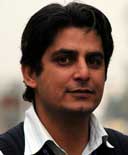Reply to comment |
The right to play . . . for Pakistanis too!
Norwegian athlete fortifies Pakistani people
Soaring trend of absentees is a tough challenge for school managers across the country where literacy rate falls a little below 50 per cent. At the same time, the northwestern region has particularly seen schools being targeted by local Taliban militants.
For a country losing 30,000 civilians and over 5,000 security personnel in suicide bombings and explosions of time devices, unemployed youth falling prey to the extremist ideology proved one the most serious challenges. While US-promised programs like Economic Opportunity Zones in Afghanistan-bordering backward tribal areas of Pakistan proved a non-starter, a simple man from Southern Pakistani Sindh province, Iqbal Jatoi, has done the trick.
Jatoi, who heads Pakistan chapter of the Right to Play, says, “Before his organization came here, sports were considered important, sans conceptual depth. We trained and inspired teachers to find their job interesting, and enabled students to be more open-minded and receptive.” Today, his team is working with over 80,000 students in the country.
“We never thought that sports can change pass-time habits of our youth and improve their academic results,” Sakeena Khanam, a mother of two daughters.
Despite odds, female enrollment in schools has increased over the past decade but parent were not too ready to let their girls play basketball or volleyball as sports were thought to be for males.
Samreen Ghauri, who supervises female coaches on daily basis, says: “Our coordination with teachers and principles in schools has yielded result with more females actively joining sports activities.” She believes that immediate fruit of sports is reduction in culture of backbiting and jealousy.
In a few years, dozens of 19 to 25-year-old coaches of basketball are imparting self-confidence and discipline as basic skills for a healthy life to the younger generation. Besides affirmative behavioral change, the RTP is filling the void of much-needed training academy for sports coaches. After a diploma, four-day workshop and a few months of field work with Right to Play, a volunteer generally gets employed as physical training instructor in a government school.
Funded by Swiss organization David Bloomer & Haefer Foundation, Right to Play’s Mansehra project began after 2005 earthquake that claimed over 80,000 people and razed most schools to the ground. Besides distributing over 70,000 sports tools and training hundreds of coaches in Pakistan,
Jatoi has taken up the mission that the government has not put on priority for decades. “We are striving to give children a chance to become constructive participants in society, regardless of gender, disability, ethnicity, social background or religion.”
He has met considerable success in engaging key Pakistani decision-makers from the development, sport, business, media and government sectors to invest more in power of sport and play. The government of Khyber Pakhtoonkhwa province, the worst victim of terrorism for over a decade, is his happy customer.
There are better basketball and volleyball courts in the province than lousy yet popular and expensive cricket.
Muntazir Khan, a resident of Mansehra district in Pakistan, is proud to see his son learn basketball at the RTP court. He advises the bigger nations engaged in global military and political enterprises to adopt values like “cooperation, hope, integrity, leadership, dedication, respect, enthusiasm and nurture” in their policies instead of arrogance and manipulation.
Abdul Jalil, a coach and coordinator for Mansehra district, says, “It is not a job for me but an activity for my personal development. I see the impact of my work in front of me, which is an enormous satisfaction.”
In the province, feared for falling in the hands of extremists, love for sports is taking every one by storm.
Despite his polio-affected legs, Hameed Gul (15) could not sit back and watch other students play basketball and football. He learnt walking briskly upside down with his hands.
“You may not enjoy it as much as football or basketball but this is my expression of will and talent both,” Gul says with pride.
He sees Koss as a kind human being instead of a Christian or a foreigner. “Whosoever brings the message of happiness for children, we pray for him” He says these are great people who “can feel and think for us thousands of miles away”.
Sports experts and sportsmen alike get inspiration from the impact of RTP work. “Sports for development is the best anti-terror strategy for the long term as much as it is nation-building tool,” says Aamir Bilal, a columnt for daily The News.
Adopting the Olympics emblem of five colored circle, the RTP interprets red circle as mind ball, black as body ball, yellow as spirit ball, blue as peace ball and green as health ball.
“We want to give the children the freedom and facilities they deserve not what they find around them. You are the symbols of a new future after massive earthquake and terrorism. The society is rising with children carrying the flag ahead of them,” Johann Olav Koss told a gathering of female students in a Mardan government school.








 Naveed Ahmad is an investigative journalist with special focus on diplomacy, security and energy politics. He jointly heads
Naveed Ahmad is an investigative journalist with special focus on diplomacy, security and energy politics. He jointly heads 